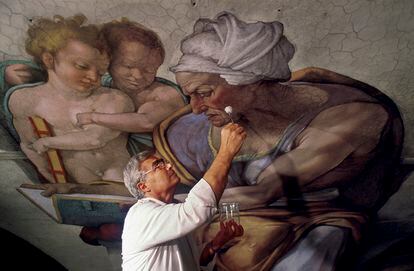On March 28, Gianluigi Colalucci, who had been chief restorer of the Vatican Museums since 1979, died at the age of 92 in Rome, the city where he was born in 1929.
Coming from a family of lawyers, Colalucci was trained at the prestigious Istituto Centrale per il Restauro, where Cesare Brandi was then acting as director, a decisive personality in the paradigm shift in training and recognition of restoration as a multidisciplinary, complex and fundamental practice for the conservation and treatment of artistic goods, beyond mere craft or repair practices.
The teaching of Brandi, or of Giovanni Urbani, another relevant professor of the time, made up the educational background of Gianluigi Colalluci who, after spending time at the Galleria Nazionale de Sicilia, became part of the Vatican staff of restorers in 1960.
Gianluigi Colalucci works with Michelangelo's 'Sibyl of Cumas' in 1986. Gianni Giansanti
Colalucci's solvency and professionalism were decisive so that in 1980 the direction of the Vatican Museums (first Fabrizio Mancinelli and Carlo Pietrangeli later) entrusted him with the direction of the ambitious and intimidating task of intervening in the Sistine Chapel, the pinnacle of painting in Rome. Michelangelo, the great titan of the Renaissance.
The vault first, with
The Creation,
and later
The Last Judgment
;
a work that developed over 15 years and that became, as the Italian media recall these days, the "restoration of the century."
Colalucci: "The cleaning of the Sistine Chapel was done with philological criteria"
The long and painstaking work was carried out under the cameras of the Nippon Television Network Corporation, after paying more than four million dollars in image rights (more than 3.4 million euros at the current exchange rate).
Never before has a restoration carried so much interest, recognition and some controversy.
Colalucci faced the challenge with as much wisdom as tranquility, supported by a complex team of chemists, historians and documentary filmmakers from his own institution, and by the conviction of someone who has a long career behind him.
Some of the greats of Italian art had passed through his hand: Rafael, Giotto, Leonardo, Guido Reni, Lorenzo Lotto, Tiziano, Andrea Mantegna, Guercino, Perin del Vaga, Dosso Dossi or Caravaggio.
Diverse works by technique or support, but where he knew how to limit the performance in the cleaning (the touchstone in the restoration of painting) or in the final adjustment in the varnishing (he had his wide smile and expressive gesture as he qualified some works with the heat from the palm of your hand).
Works that were part of his impeccable know-how, and the entertaining account of his condition as a great conversationalist (Roman after all).
His experience and the remarkable esteem achieved, led him to be summoned as a lecturer or professor at various universities and centers in the United States, Australia, Japan and Europe, including Spain, where his teaching was extended especially at the Polytechnic of Valencia, there he was appointed doctor
honoris causa
(it was also, among others, by the New York University).
As Barbara Jatta, current director of the Vatican Museums, recalled, Colalucci's death is sad news for the world of restoration: "He has left us a great man, a great professional and one of the greatest restorers of the century."
The causes of death have not been revealed.
Leticia Ruiz Gómez is
director of the Royal Collections of the National Heritage.

